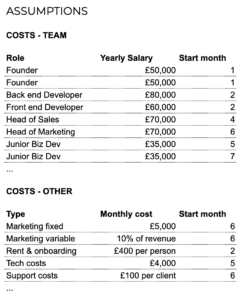How to budget as an early-stage startup
So you’ve just incorporated your startup, printed several thousand business cards, and changed your laptop screensaver to “I’m the CEO”.
Now is the time to show future investors they can trust you by building a beautiful budget – because naturally, you know what you’re doing!

Exciting possibilities lie before you – how are you going to allocate your funds? How much to hiring? Product? Marketing? Unlimited coffee?
This is where the trusty spreadsheet comes in… an inevitable recurring character for all startups.
1) Expense budgeting
For each cost, write down the amount and the month it starts. So if you’re hiring a software engineer, you’d write their annual salary and the month you plan to hire them. Once all your lines are written down, the magic of spreadsheets lets you automatically break this down into monthly costs.
2) Revenue budgeting
Do the same for your revenue plan. Divide it into different lines representing your income sources, factoring in all the stuff you tried to forget from school: customer acquisition costs, expected growth rate per channel, recurring versus one-off revenue etc. Add in any one-off cash injections like the money you managed to convince your elderly neighbour to ‘invest’.
Tips and tricks
When building expense and revenue budgets, you can make things more complicated (and thus more impressive!) by using drivers, formulas and percentages.
For example, you might want your marketing to scale with a percentage of your revenue, your support and infrastructure costs to scale with your number of clients, or your rent and onboarding costs to scale with number of employees.
3) Bringing it all together
One handy way to do this is to use multiple spreadsheet tabs with your different assumptions, and a tab putting everything together within a monthly view. Here you want a line subtracting your expense from your revenue (this is your profit/ loss), and a line that adds up this line cumulatively to get your ending balance.

Now you can work out some key budgeting stats:
- Runway: the month before all goes to shit and you run out of money.
- Cashflow positive: the month when you can organise a massive party because YOU’RE MAKING A PROFIT!!!
From this you can decide if you need to tweak your budget (eg decrease expenses), when to budget more expenses (eg new hires), when to raise a round (once you’ve proved scalability but far in advance of your max runway month), and when to despair.
Tracking your budget (rather than let it rot in your Google Drive)
As founder of an early-stage startup, you get the amazing privilege of coming in every month or so and course-correcting assumptions: increasing expenses when your junior BizDev accidentally miss-types an extra 0 in their ad campaign cost, or increasing revenue projections after managing to convince a client to sign up for the “Ultra-Premium” package.
A good practice here is to copy your budget before you adjust it, so you can keep track of how terrible your predictions are over time. You can get expenditure and revenue data from your accounting system or, because there’s few actuals at this stage, directly from your bank.
Crucially this is a chance to adjust your strategy as you go, rather than blindly charge into a wall. If you’re making a lot less revenue than expected, you might want to delay expenditure. If you’re making more, you want to accelerate instead. If your runway date starts to loom closer and your revenue is nowhere near your predictions, it’s time to re-evaluate your (company’s) life.

Good luck, and happy budgeting!
About me:
I’m the founder of Beyond, providing budgeting software for fast-moving SMEs. Beyond automates the day-to-day, so budget holders and finance teams can spot risk and confidently plan for the future.
